-
Paper Information
- Paper Submission
-
Journal Information
- About This Journal
- Editorial Board
- Current Issue
- Archive
- Author Guidelines
- Contact Us
American Journal of Systems Science
p-ISSN: 2332-8452 e-ISSN: 2332-8460
2018; 6(1): 1-15
doi:10.5923/j.ajss.20180601.01

Explaining Natural Patterns Using Systems Thinking
Jamie P. Monat
Systems Engineering Program, Worcester Polytechnic Institute, USA
Correspondence to: Jamie P. Monat, Systems Engineering Program, Worcester Polytechnic Institute, USA.
| Email: |  |
Copyright © 2018 Scientific & Academic Publishing. All Rights Reserved.
This work is licensed under the Creative Commons Attribution International License (CC BY).
http://creativecommons.org/licenses/by/4.0/

Patterns in nature are common, from zebra stripes to geese flying in V-formations to the nautilus’s spiral. In systems, the presence of a pattern indicates that there are several factors acting in feedback loops; those feedback loops are, in turn, caused by underlying laws or forces such as gravity, electrostatic attraction/repulsion, friction, surface tension, fluid shear, chemical potential, pheromones, and aerodynamic lift. The feedback loops cause the systems to oscillate and the oscillation is interpreted as an emergent pattern. Systems Thinking (specifically the Iceberg Model and causal loops) may be used to explain natural patterns. Understanding what causes natural patterns may help us to influence them, but more importantly, to translate that knowledge to the design and improvement of human-based systems.
Keywords: Systems Thinking, Patterns, Feedback, Emergence, Self-organization
Cite this paper: Jamie P. Monat, Explaining Natural Patterns Using Systems Thinking, American Journal of Systems Science, Vol. 6 No. 1, 2018, pp. 1-15. doi: 10.5923/j.ajss.20180601.01.
Article Outline
1. Introduction: Systems Thinking
- According to Monat and Gannon (2015a and b, 2017) Systems Thinking is a perspective, a language, and a set of tools. It focuses on relationships among system components (as opposed to the components themselves), it is holistic instead of analytic, it recognizes that systems are dynamic and usually include multiple feedback loops, and it acknowledges that systems often exhibit emergent and self-organizing behaviors. In those previous works, Monat and Gannon have shown how Systems Thinking can explain and address political and socio-economic issues. In this paper, we describe how Systems Thinking can explain a great many natural patterns in the world: why zebras have stripes, why geese fly in a V-formation, why fish school, why the universe looks as it does, and how life began on earth. The explanation begins with the Iceberg Model.The Iceberg Model. Systems Thinking posits that repeated events or objects represent patterns and that those patterns are caused by systemic structure, which is (in turn) caused by underlying forces. The patterns are often emergent, meaning that they cannot be predicted from knowledge of the system components; only when those components interact do the patterns emerge. The underlying structures represent the interactions or relationships among system components: the system’s stocks, flows, and feedback loops. Structures develop because of natural underlying forces in natural systems or because of mental models in human-designed systems. The Iceberg Model conveniently shows the relationships among events, patterns, structures, and underlying forces (Figure 1).
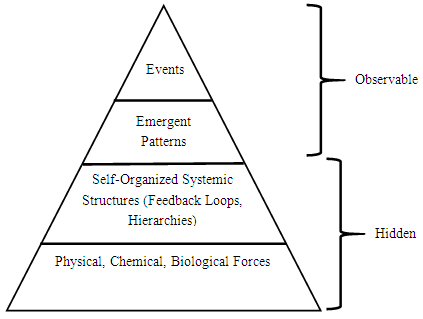 | Figure 1. The Iceberg Model for Natural Systems (after Monat and Gannon, 2015a) |
2. Patterns
- Businessdictionary.com defines a pattern as a consistent and recurring characteristic or trait that helps in the identification of a phenomenon or problem, and serves as an indicator or model for predicting its future behavior. Patterns may be physical, temporal, behavioral, psychological, or some combination. Examples of physical patterns include stripes on zebras, crystals, sand dunes ripples, compound fly eyes, and termite cathedrals. Temporal patterns are exemplified by predator-prey populations over time, Newton’s cradle, my boss being grouchy every Thursday, and the spawning runs of salmon every autumn. Combination physical-temporal patterns include traffic jams, birds flocking, and fish schooling.
3. Emergence
- Natural patterns are usually emergent—that is, they are properties of the system that cannot be predicted from the properties of the system’s components. These emergent properties develop as result of the relationships among the system elements or between the system elements and the environment. The V-formation of geese, for example, could not be predicted from the flying characteristics of a single goose. It is only when several geese fly together that the V-pattern emerges. Similarly, fish schooling would not be predicted form the swimming characteristics of a single fish. Camazine et al. (2001) say, “Emergence refers to a process by which a system of interacting subunits acquires qualitatively new properties that cannot be understood as the simple addition of their individual contributions.” Johnson (1999) says, “Emergence is what happens when an interconnected system of relatively simple elements self-organizes to form more intelligent, more adaptive higher-level behavior. It's a bottom-up model; rather than being engineered by a general or a master planner, emergence begins at the ground level. Systems that at first glance seem vastly different--ant colonies, human brains, cities, immune systems--all turn out to follow the rules of emergence. In each of these systems, agents residing on one scale start producing behavior that lies a scale above them: ants create colonies, urbanites create neighborhoods.” Emergent patterns are often a result of self-organized systemic structures such as feedback loops and hierarchies, which are in turn caused by underlying forces.
4. Structure
- Systemic structure is the way that system elements are linked together and relate to each other, as well as to their environment. Meadows (2008) defines structure as the system’s interlocking stocks, flows, and feedback loops. Natural structures are self-organized and include the structure of atoms and solar systems, the physical structure of an animal or crystal, and the herds and flocks of grouped animals. Feedback loops, self-organization, and hierarchies are important elements of natural system structure.Feedback Loops Multiple feedback loops are present in most systems. As shown in Figure 2, these feedback loops may be positive/reinforcing (such as compound interest on a savings account) or negative/balancing (as a home thermostat or cruise control on an automobile.)
 | Figure 2. Balancing and Reinforcing Feedback Loops |
 | Figure 3. Behavior-Over-Time Plot for Predator and Prey |
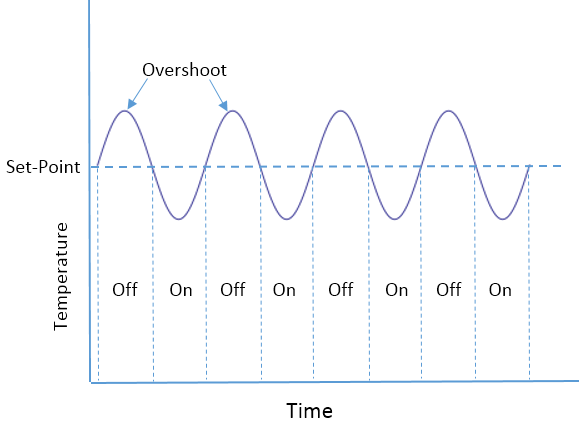 | Figure 4. Temperature Oscillation in a Domestic Heating System |
 | Figure 5. Hierarchical Pattern |
5. Underlying Forces (Mechanisms of Self-Organization)
- In natural systems, there are many underlying forces yielding self-organization:Ÿ Physical mechanisms such as gravity, electromagnetic force, the strong and weak nuclear forces, aerodynamic lift, fluid shear, friction, pressure, mechanical forces, centrifugal forceŸ Chemical mechanisms such as pheromones, the electronic charge of ions, Vander Walls forces, hydrophilicity/hydrophobicity, chemical potential, the physical shape and structure of moleculesŸ Instinctive survival mechanisms such as swarming, flocking, schooling, herding to afford a competitive advantageŸ Comfort/Discomfort perceptions such as safety zones, sensitivity to heterogeneity, separation, alignment, and cohesionIn human-designed systems, the underlying forces are typically mental models such as “incentive compensation increases productivity,” “honesty is the best policy,” and “competition brings out the best in people.” Several examples of patterns, their underlying structures, and the structures’ causative underlying forces are presented in Table 1.
|
6. Patterns in Nature
- There are hundreds of patterns occurring naturally. Although some of these seem beyond understanding, systems thinking may be used to explain each of them.Sand Dune Ripples. The intricate ripples in sand dunes (Figure 6) are explainable using Systems Thinking. As wind moves along a flat bed of sand, it may happen to dislodge a single sand grain, carry it along for a bit, and then deposit it on top of the flat sand surface. This obstacle causes the horizontal wind to divert upwards. This upward wind direction then carries additional sand grains over the original grain and deposits them. The pile of sand is now a little bigger and causes the wind to bend upwards even more. As the process continues, more and more sand accumulates until the slope is so steep that a mini-avalanche of sand occurs due to gravity. Meanwhile, the shape of the newly-formed ripple causes the wind to detach from the surface, re-attach downstream, and repeat the process (Makse, 2017.)In this situation, the feedback loop is physical: The result of the wind force (the sand ripple) impacts the wind force itself (the wind direction) which then impacts the shape of the ripple, which, in turn, impacts the direction of the wind in a reinforcing feedback loop that continues until gravity topples the top of the ripple. Wind accumulates; gravity topples. This is an example of a reinforcing feedback loop proceeding to failure (due to an interruption by gravity) and then starting up again.
 | Figure 6. Sand Dune Ripples |
 | Figure 7. Salt Crystals |
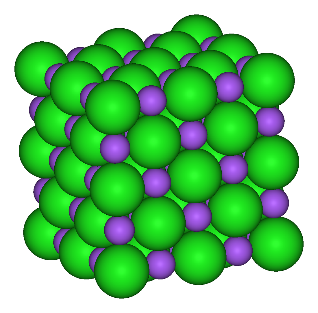 | Figure 8. NaCl Ion Pattern. The green spheres represent Cl- ions and the purple spheres represent Na+ ions |
 | Figure 9. Newton’s Cradle |
 | Figure 10. Stabilizing Feedback Loop for Newton’s Cradle |
 | Figure 11. Zebra Stripes |
 | Figure 12. Balancing Feedback Loop for Zebra Stripes |
 | Figure 13. Fly Eyes |
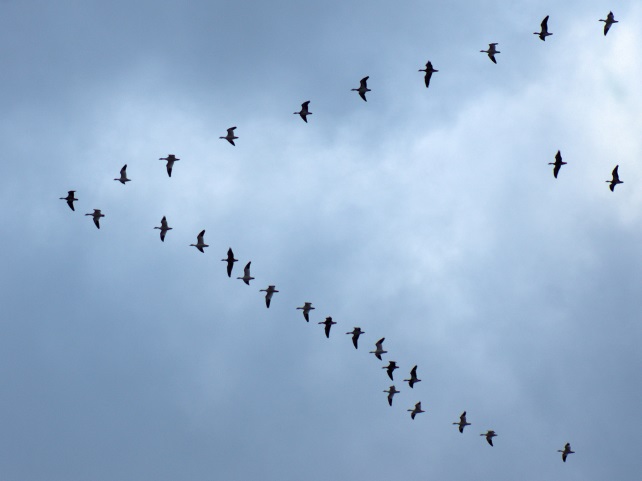 | Figure 14. Geese in V-Formation |
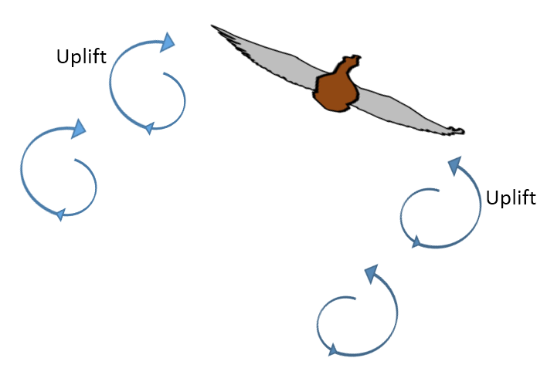 | Figure 15. Trailing Vortices |
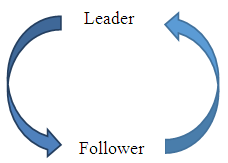 | Figure 16. Reinforcing Feedback Loop for Geese |
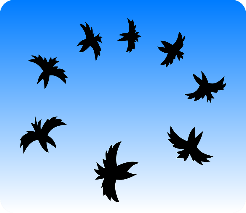 | Figure 17. Geese Flying in a Circle |
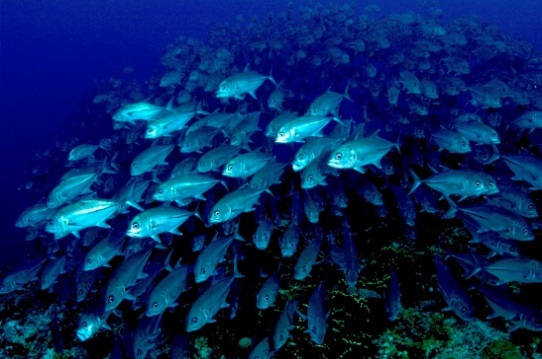 | Figure 18. Fish School |
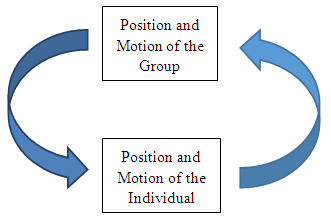 | Figure 19. The Dominant Feedback Loop Describing Group Motion |
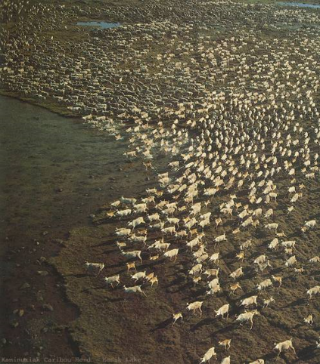 | Figure 20. Arctic Caribou Herd |
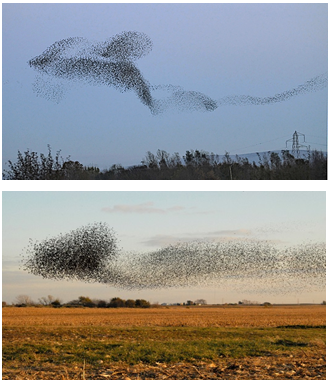 | Figure 21. Examples of Bird Murmuration |
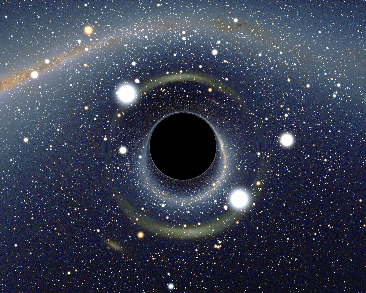 | Figure 22. Black Hole |
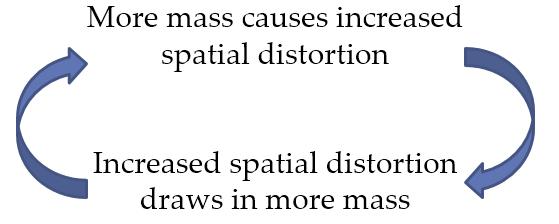 | Figure 23. The Black Hole Reinforcing Feedback Loop |
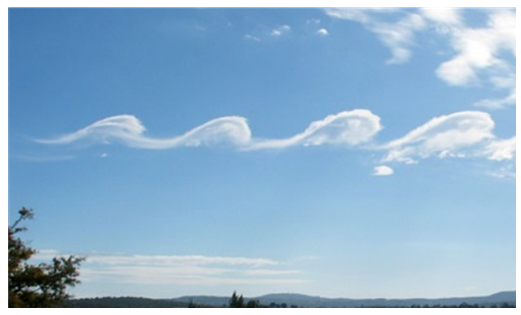 | Figure 24. Kelvin-Helmholz Clouds |
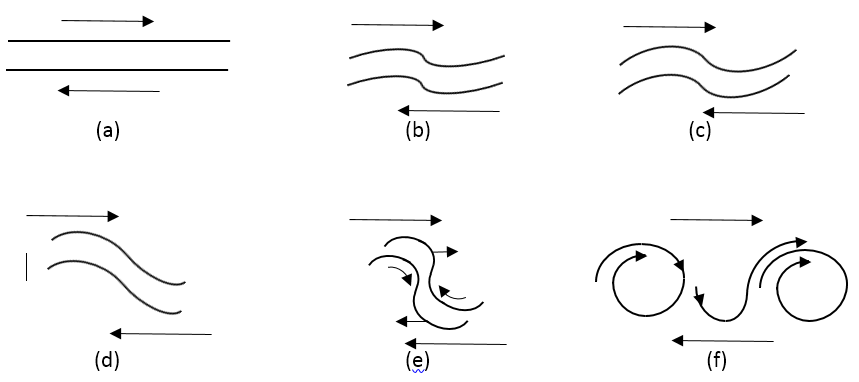 | Figure 25. The Formation of Kelvin-Helmholz Clouds |
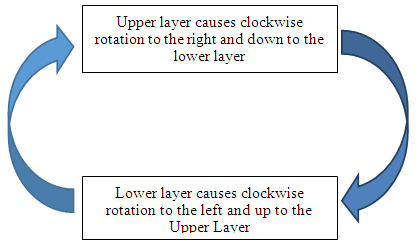 | Figure 26. Reinforcing Feedback Loop for Kelvin-Helmholz Cloud Formation |
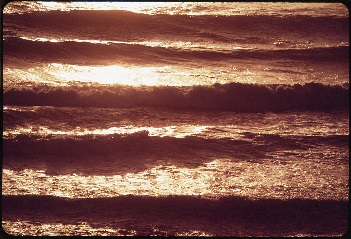 | Figure 27. Pattern of Ocean Waves in a Line |
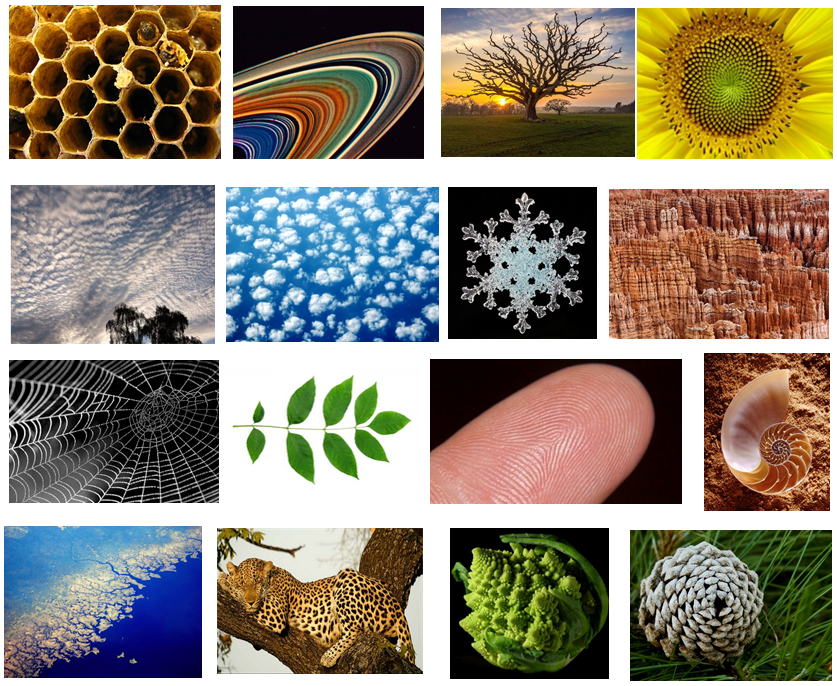 | Figure 28. Additional Natural Patterns |
7. Patterns Deriving from Man’s Activities
- Although this paper focuses on natural patterns, there are many patterns that derive from man’s activities. Traffic patterns (especially traffic jams; Figure 29) are 1-dimensional versions of the herding/schooling/flocking behavior observed in animals. Drivers are following 2 basic opposing rules: 1) get to my destination as fast as possible and 2) don’t have an accident. These basic mental models translate to a “safe” speed (which is a function of the space between cars) and a “safe” following distance (which is a function of the speed) in a stabilizing feedback loop. When traffic piles up in a jam, the pattern from above appears as a backwards-travelling wave of denser-packed cars moving through the line of traffic.
 | Figure 29. Traffic Jam |
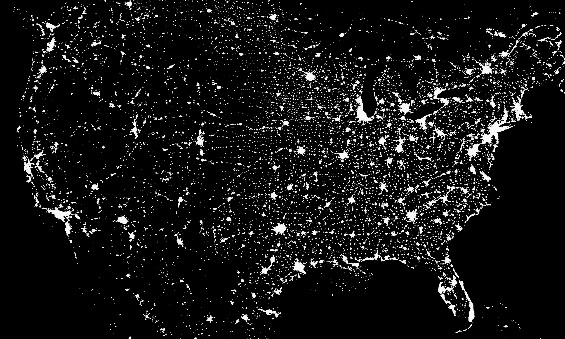 | Figure 30. Pattern of U. S. Cities |
8. The Structure of the Universe
- There are several repeated patterns in the universe, from the pinwheel shape of spiral galaxies to the patterns of planets orbiting their sun and moons orbiting their planets. Systems Thinking teaches us that patterns are caused by underlying structure, which (in turn) is caused by underlying forces. These concepts are useful in understanding those patterns.The universe appears to be hierarchic: planets (some with moons) embedded within solar systems, solar systems within galaxies, and galaxies in clusters, and these basic structures are repeated many times. Can Systems Thinking and the underlying forces of gravity, electromagnetism, centrifugal, and the nuclear forces explain the structure of the universe, and is the universe self-organizing?As an example, consider the repeating pinwheel pattern of spiral galaxies in which the shape of each curved radial arm is repeated many times (Figure 31). This pattern is formed by 2 opposing forces: centripetal force Fc (Fc = mv2/r) and gravity Fg (Fg = GMm/r2) where m=the mass of a galactic star, v=the tangential velocity of the star, G= the universal gravitational constant, M = the mass of the galaxy (concentrated at its center), and r= the radial distance of the star from the center of mass. Fg and Fc must be balanced, or else the stars would either all collapse into the galactic center or fly out of orbit and leave the galaxy. If one equates these 2 forces, one obtains the equation v=(GM).5/r.5 which indicates that the tangential velocity of a star in the galaxy is proportional to the square root of the reciprocal of the star’s distance from the center of the galaxy: that is, more distant stars revolve more slowly1. Over time, the more distant stars lag behind the closer stars in their counter-clockwise motion around the galaxy’s center of gravity. The result is the classic pinwheel shape shown in Figure 31.
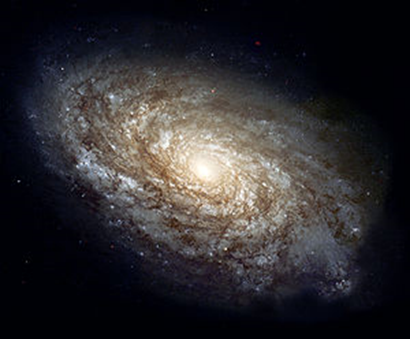 | Figure 31. Spiral Galaxy NGC 4414 |
 | Figure 32. Orbital Speeds of Planets |
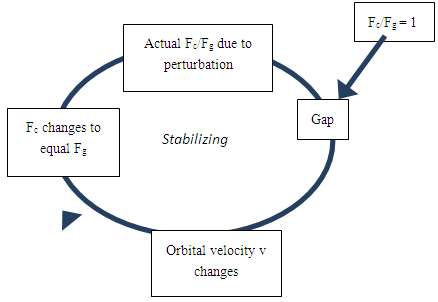 | Figure 33. Stabilizing Feedback Loop of Orbital Mechanics |
9. The Origins of Life on Earth
- DNA forms a beautiful double helix molecular pattern (Figure 34) with a basic phosphate-ribose-base structure repeating millions of times. Could Systems Thinking concepts, specifically hierarchical system evolution and molecular self-organization, explain the origins of life on earth? Conventional wisdom argues that a DNA-like precursor was the first form of reproductive life. Sir Fred Hoyle and Chandra Wickramasinghe (1981) have demonstrated the statistical improbability of all the elements in the Archean environment randomly coming together in just the right sequence to form a molecule of DNA (which comprises millions of atoms.) But was it truly random? Inspection reveals that the DNA molecule is hierarchic, with 3 repeating fairly simple sub-units: a phosphate group, a ribose (sugar) group, and a base (adenine, cytosine, thymine, or guanine) connected in a chain and mated to a complementary chain in a double helix. Could a complex DNA molecule have evolved from these much simpler sub-units? The probability of DNA self-organization increases dramatically if its evolution is split into stages: 1) self-organization of each of the 3 basic sub-units independently followed by 2) self-organization of those sub-units into a section of DNA, and then 3) the linking of many such sections to form a long molecule. Scientists have been able to demonstrate the self-organization of amino acids, the sugar, the phosphate, and some of the base groups from a primordial soup of base chemicals (Miller and Urey (1953 and 1959), Oro (1960 and 1961), Keller, Turchyn, & Ralser (2014)), but they have not yet succeeded in demonstrating the self-organization of those constituents into a nucleotide. But self-replication of inanimate chemical structures has been demonstrated. Self-replicating chemical systems (Fulvene, Rotaxone) are well-known to scientists, and Eigen has explored autocatalytic sets of reactions that may be responsible for the self-organization of life (Eigen, 1971). His hypercycle (a reinforcing feedback loop) describes a closed loop of self-replicating molecules, each one of which catalyzes the creation of its successor (see Figure 35). Eigen successfully demonstrated that this chemical cycle displays Darwinian natural selection at the molecular level (Bahnzhaf, 2010.)
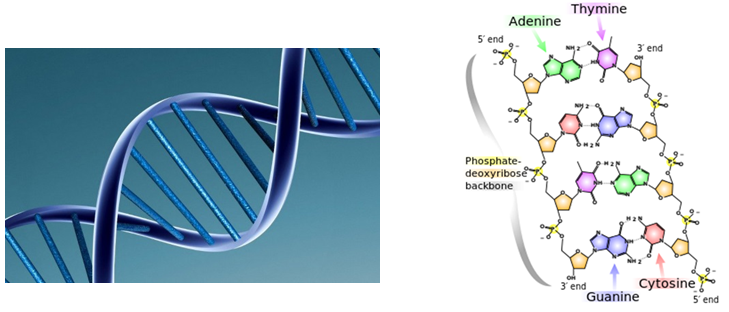 | Figure 34. Pattern of DNA |
 | Figure 35. The Hypercycle. Reproduced from Eigen & Schuster (1979). Ei = an enzyme and Ii = an RNA matrix. Each enzyme increases the replication rate of its subsequent RNA |
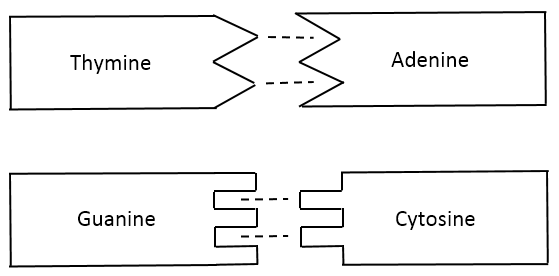 | Figure 36. The “Lock-and-Key” Mechanism for Base Pair Bonding in DNA |
10. Discussion
- Natural patterns confront us every day. Many seem to defy understanding. However, if one realizes that patterns represent physical, temporal, chemical, or emotional oscillations, it becomes easier to fathom them. There have been previous attempts to explain natural patterns. D’Arcy Wentworth Thompson (1917) argued that physical laws and mechanics play a vital role in determining the structure and morphology of organisms. His main thrusts, however, seem to be to try to explain the evolution of living organisms using mathematics and the morphology of distortion; he never explains animal behavior, non-biological morphologies, or the feedback loops that yield oscillations and patterns. In his seminal paper, Alan Turing (1952) developed the reaction-diffusion mechanism to explain patterns in living organisms based on chemical and physical laws. He states, “The theory does not make any new hypotheses; it merely suggests that certain well-known physical laws are sufficient to account for many of the facts.” He comes close to the systems thinking philosophy (and indeed articulates several elements of it) but doesn’t integrate them into a broadly-applicable theory; specifically he does not explain inanimate or behavior patterns.Mano (2004) does a nice job explaining natural patterns as a result of self-organization, as well as the advantages of self-organization, but he does not invoke feedback loops or detail the biological, chemical, and physical mechanisms that yield self-organization. He also suggests that the patterns we see were “stumbled upon” by chance. He proposes self-organization as a solution to a biological problem: “One of the mysteries of biology is how the enormous amount of morphogenic, physiological and behavioral complexity of living organisms can be achieved with the limited amount of genetic information available within the genome. Self-organization is one solution to this problem………… Through self-organization, evolution has stumbled upon a wide range of extremely efficient, relatively simple solutions for solving very complex problems.”In his ground-breaking book The Life of the Cosmos, Lee Smolin (1999) hypothesizes that our entire universe is a self-organized system, rife with feedback loops, hierarchies, and emergent patterns at all scales in galaxies, planetary systems, and atoms. He speculates that the laws of physics (and their concomitant universes) are not fixed, but evolve over time in a form of Darwinian natural selection. Although the book is full of systems thinking concepts, Smolin does not integrate them into an overarching systems thinking framework.In his beautiful book, Patterns in Nature, Philip Ball (2016) describes dozens of natural patterns, including mud cracks, fern spirals, fractals, animal skin patterns, beehives, herding/schooling patterns, and flow patterns. He attempts to explain each using scientific principles, and he even refers to feedback loops occasionally. But he doesn’t articulate the underlying causality in all these and misses integrating them into an overarching systems theory explanation involving causal loops, feedback, and hierarchies.Parveen (2017) explains patterns mathematically, arguing that Fibonacci sequences often provide the most efficient light-gathering structures or the highest surface area: volume ratios, but he does not explain how natural systems generate those mathematical structures.Although these explanations have merit, they miss the integrated theory afforded by Systems Thinking, specifically the theory that emergent patterns represent oscillations caused by self-organized structure (feedback loops) which in turn, are caused by underlying forces, and that these apply to both living and non-living entities as well as to physical, temporal, emotional, and behavioral patterns. These concepts are the essence of Systems Thinking.Systems Thinking addresses many questions about natural patterns by invoking concepts such as feedback loops, self-organization, hierarchies, and emergence. However, it also introduces others.The Nature of the UniverseŸ As Lee Smolin (1999) suggests, is our whole universe a complex self-organized system, and can the universe exist and be self-organized without a prime mover?Ÿ What are the minimum requirements for a universe to self-organize?Ÿ Are the natural laws such as gravity really laws or are they just properties of the space we inhabit? The Nature of Life and Self-AwarenessŸ Is life itself an emergent property deriving from the self-organization of hierarchical elements? Ÿ Should our definition of “life” not be binary (either living or not-living) but more a continuum with some threshold beyond which we define as “alive”?Ÿ Is self-awareness an emergent property of a sufficiently complex self-organized brain, and can any sufficiently complex entity become self-aware?Ÿ What is the next step of emergence for humanity--the inter-connectedness of all humans into 1 super-being (Monat, 2017)?These intriguing questions exhort study through the application of Systems Thinking.
11. Conclusions
- In this paper, we have explored some of the patterns observed in nature, and used Systems Thinking to explain how and why they came to be. The concepts of feedback loops, hierarchies, self-organization, and emergence contribute to our understanding of these natural patterns. This understanding may help us to influence our natural world in positive ways, and to facilitate the design and improvement of human-designed systems, which is a topic for a future paper.
Note
- 1. Present-day studies indicate that the tangential velocity of many galactic stars do not follow the inverse square-root law of Keplerian mechanics. This observation has led to the speculation of both the existence of dark matter and a modification to Newton’s law of universal gravitation (Milgrom, 2015). However, all known theories account for the outer galactic stars moving slower than inner stars, although they vary in details.
 Abstract
Abstract Reference
Reference Full-Text PDF
Full-Text PDF Full-text HTML
Full-text HTML